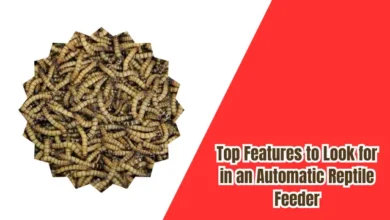You probably can’t name many animals right now from the top of your head that start with the X letter, right? That’s probably because you don’t usually hear of many animals that have names starting with X. in this article, we will introduce the names of animals that begin with x.
15 Amazing Animals Animals That Begin With X
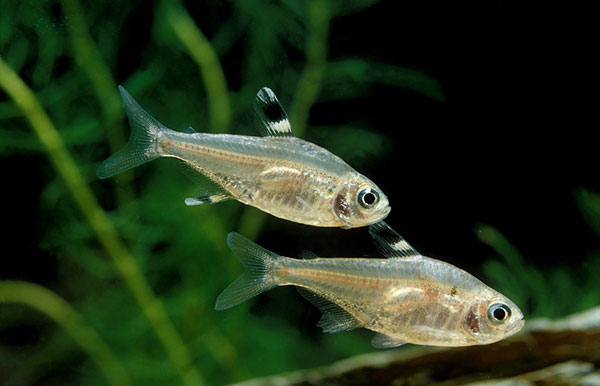
Read More:
- How Do Dogs Communicate With Humans
- Tips for Adopting a Dog When You Have Small Children
- How to Make Your Bird Happy: Useful Pieces Of Advice
- The Ultimate Guide to Train Your Dog to Get Along with Your Bird
- Feeder Insects: Nutrition Values
1. X-Ray Tetra
The X-Ray Tetra is a schooling fish that can usually be found in the coastal waters of the Amazon River in South America.
The X-Ray Tetra is a small fish species that has a light golden color of their translucent skin.
These are small and colorful fish that inhabit the bottom and middle regions of the water in a school.
These fishes are widely kept in tanks and are very peaceful and tolerant of other species.
The X-Ray Tetra is most clearly identified by its translucent layer of skin that allows its backbone to be visible.
This fish also has striped dorsal and anal fins, and they are strikingly yellow, black, and white in color.
2. Xerus
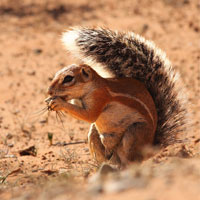
This is an African ground squirrel that can primarily be found in burrows in Africa.
These animals are social and have short and coarse hair. In captivity, they are known to survive around 11 years.
The fur of these squirrels is light-brownish and covers them from head to toe, with their feet having less hair than other parts of the body.
They have a flat tail and small ears with long and curved claws. They weigh up to 14 ounces and are about 18 inches tall.
Their tail makes up one-third of its total length, which they use to protect themselves in the scorching heat.
3. Xantic Sargo
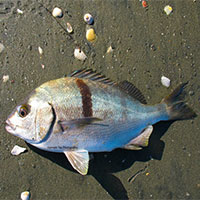
The Xantic Sargo belongs to the grunt fish family. The name derives from the grunting sounds these fish produce by rubbing their flat teeth plates together.
This fish has an elongated body, pouty lips, and a back that is elevated and compressed.
It has a silver body with a vertical stripe that is black or brown on both sides. The fully grown Xantic Sargo fish are mostly up to eleven inches long.
4. Xantus’s Hummingbird
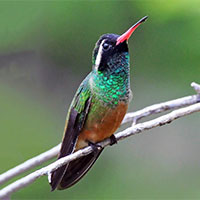
The Xantus’s Hummingbird is a hummingbird from the Baja California Peninsula.
It is a medium-sized bird that is 8-9 cm long and about 3-4 grams in weight.
The adult birds have mostly green-colored backs and on the upper parts.
The tail of this bird is mostly reddish-brown in color, having faint black tips. The most visible feature is the white eye stripe that both the females and the males have.
It is similar to the White-eared Hummingbird. a bolder black stripe borders the lower side of the white eye stripe.
5. Xoloitzcuintli

The Xoloitzcuintli is more commonly referred to as Xolo or even the Mexican Hairless.
These dogs may be descendants of the first dogs that arrived on the North American continent.
These are purebred dogs and relatively uncommon. However, they are occasionally seen in shelters and rescues.
The Xoloitzcuintli can be seen mostly in three sizes: miniature, standard, and toy.
Additionally, they come in two varieties: coated and hairless. The skin of the hairless breed is tough, smooth, and close-fitting.
The coated variation has a short and flat coat. Both types are dark colors, including black, gray-black, slate, liver, red, and bronze.
The facial impression is intelligent and thoughtful, and when a Xolo has a serious thought, his forehead wrinkles.
The graceful, elegant body of the Xolo is deceptively strong and rugged.
6. Xenarthra
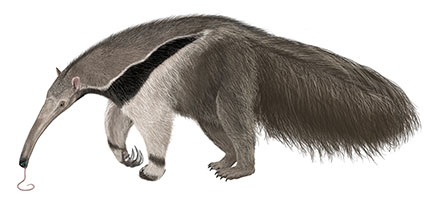
Armadillos, anteaters, and sloths are all members of the Xenarthra, a group of eutherian mammals.
They were once classified in the order Edentata and often referred to as edentates, a term derived from the Greek word for “toothless.”
While xenarthrans like anteaters are toothless, the enormous armadillo may have up to 100 teeth, more than any other animal.
Edentata members include the 31 extant species of armadillos, tree sloths, true anteaters, and eight extinct ground sloths and armadillo-like creatures.
Thus, the Xenarthra is comprised of both living and extinct families.
7. Xerus
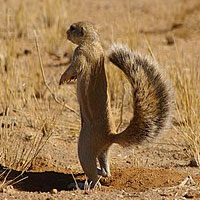
Xerus Erythropus, often referred to as the African ground squirrel, is a native of Africa.
They are considered to be friendly creatures with coarse and short fur.
They are capable of living in captivity for approximately 11.5 years.
Males and females move and live in different and separate groups until they mate, at which point the infants join their moms in the female group. Four subspecies of the Xerus exist:
- The striped ground squirrel
- The mountain ground squirrel
- The cape ground squirrel
- The unstriped ground squirrel
These creatures are nocturnal and are often herbivores in nature, consuming roots, nuts, and seeds. However, they sometimes consume eggs and other tiny animals.
8. Xami Hairstreak
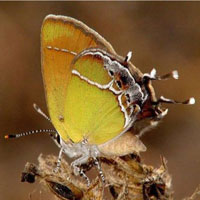
Callophrys Xami, often known as the Xami hairstreak, is a butterfly of the family Lycaenidae.
It is a member of the subgenus Xamia and thus the genus Callophrys.
It is a tailed butterfly with a wingspan of between 2.38 and 2.86 cm.
The underside of the hindwing exhibits yellowish-green in color; the wing also includes the postmedian silver-white line, a noticeable colored line posterior to the wing’s center that creates a W-shape near the butterfly’s tails.
The juniper hairstreak and silver-banded hairstreak are two species that resemble C. Xami.
However, the primary distinction between the two species is that the juniper species has a strong W mark in the postmedian white band, while the silver-banded species has a wider silver-white postmedian line.
9. Xantus’ Murrelet
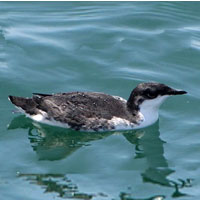
The Xantus’ Murrelet is a tiny auk, measuring only about 10 inches in length and weighing just 6 ounces.
It is named for John Xantus de Vesey, a Hungarian ornithologist who identified it from specimens obtained off the coast of Baja California.
There are two distinct races or groups, Northern and Southern, identified by their facial pattern: Southern breeders have an average bill of about 8% longer and 5% thinner.
Additionally, they have white extending up above and in front of the eye and white above the bill’s base, and a larger white crescent just below the eye.
It is black on the upper parts and white on the cheeks, neck, underparts, and underwings.
10. Xingu Corydoras
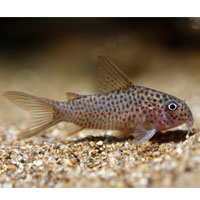
The Xingu corydoras are native to South America, where they live in the upper reaches of Brazil’s River Xingu.
As with other corydoras species, they are ubiquitous in the aquarium community; they are very calm in the tank and are capable of doing odd acrobatics in the water, much to their keepers’ pleasure.
Although the Xingu corydoras may not be as common in aquatic shops as other corydoras species, they are worth seeing.
They acquire a pinkish tint to their primary body coloration as they grow, which is broken up by brown speckles.
Adults reach a maximum length of 1.5 inches, making them suitable for aquariums with limited space.
If properly maintained, the Xingu corydoras have an average lifespan of approximately five years.
11. Xenops
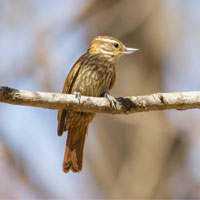
Xenops is a genus of tiny birds that may be found across South America and Central America.
Instead of being a distinct species, Xenops is a genus, a group of closely related species.
Xenops are tiny birds with relatively long tails, narrow yet deep beaks, and a brown / rufous-brown coloring.
They forage for insects in all directions across the surface of trees. Unlike woodpeckers, Xenops do not probe the bark using their tails as support.
As a result, xenops are often ignored. They are difficult to detect due to their tiny size and inconspicuous plumage.
12. Xucaneb Robber Frog
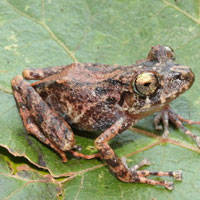
Craugastor Xucanebi, often referred to as the Xucaneb Robber Frog, is a frog species belonging to the genus Craugastoridae.
It originated in Guatemala. Sierra de Los Cuchumatanes, Sierra de las Minas and Sierra de Xucaneb are the known locations for the species in Guatemala’s central highlands.
Premontane and montane forests at altitudes of 600–1,300 m (2,000–4,300 ft) above sea level are their native habitats.
It is usually found in dense undergrowth and shrubs and could also be found in somewhat degraded forests.
13. Xenicus Gilviventris
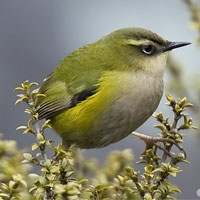
The New Zealand rock wren, also known as Xenicus gilviventris, is a tiny New Zealand wren originating on New Zealand’s South Island.
Outside of New Zealand, it is sometimes referred to as the rock wren.
Sometimes South Island wren to differentiate it from the unrelated North American rock wren.
The rock wren is a very tiny, virtually tailless bird that likes to jump and run on its long legs and flies only short distances on its rounded wings.
Males weigh 16 g, and females weigh 20 g. Males are a bit greenish with yellow flanks with a pale underside, while females are often browner.
However, the degree of sex difference varies geographically.
14. Xenoceratops
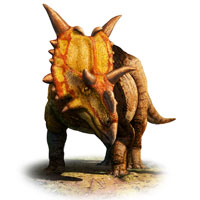
Xenoceratops is a centrosaurine ceratopsid dinosaur that was discovered in the Late Cretaceous period’s middle Campanian stage.
The species’ fossil remains were found in Alberta, Canada. M. J. Ryan, D. C. Evans, and K. M. Shepherd named and described the species for the first time in 2012.
The discovered fossil representation consists of partial frills with horn material from more than three individuals.
Although the structure and weight of Xenoceratops remain unknown owing to the fragmentary remains, its length has been estimated to be about 6 meters.
15. Xanthichthys
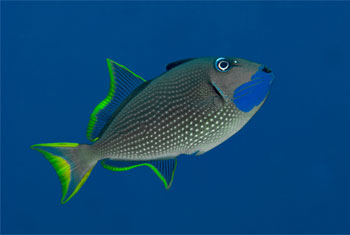
Xanthichthys is a genus of triggerfish found in reef settings across the western Atlantic, Indian, and Pacific Oceans. This genus has six known species.
They are Xanthichthys Ringens, also known as sargassum triggerfish; Xanthichthys Auromarginatus, also known as gilded triggerfish; Xanthichthys Greenei, also known as Kiri triggerfish; Xanthichthys Caeruleolineatus, also known as outrigger triggerfish; Xanthichthys Lineopunctatus, also known as striped triggerfish; and Xanthichthys mento also known as redtail triggerfish.
Hopefully, the information we shared was sufficient to give you knowledge about all these animals you probably hadn’t heard of before. Well, now you know of 15 more Animals That Start With X. I Hope you had an interesting read.

